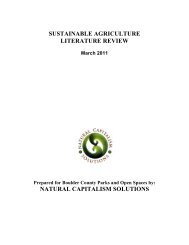Northwest Colorado 4-H EXPO - Colorado State University Extension
Northwest Colorado 4-H EXPO - Colorado State University Extension
Northwest Colorado 4-H EXPO - Colorado State University Extension
You also want an ePaper? Increase the reach of your titles
YUMPU automatically turns print PDFs into web optimized ePapers that Google loves.
RUMINANT ANIMALS:<br />
1 | P a g e<br />
<strong>Northwest</strong> <strong>Colorado</strong> 4-H <strong>EXPO</strong><br />
2012 SHEEP STUDY GUIDE<br />
A sheep is a ruminant animal. They<br />
have four compartments to their<br />
stomach (rumen, reticulum, omasum,<br />
abomasum).<br />
Ruminant animals ruminate.<br />
Ruminating is when the animal<br />
regurgitates their feed into what is<br />
called a “cud” to further breakdown<br />
their feed with their teeth.<br />
Sheep can eat roughages (hays) and<br />
concentrate (grains).<br />
Sheep Study Guide 2012<br />
Name the four different compartments<br />
of the stomach of sheep.<br />
___________________________<br />
___________________________<br />
___________________________<br />
___________________________<br />
DID YOU KNOW: The<br />
rumen in a mature<br />
sheep can hold 10<br />
gallons?<br />
6 essential nutrients for<br />
sheep<br />
Protein<br />
Fat<br />
Carbohydrates<br />
Vitamins<br />
Minerals<br />
WATER<br />
“What one do you think is<br />
the most important?<br />
_____________<br />
Lamb and Mutton Grading Systems<br />
(Lamb is meat from sheep less than a year old and Mutton is meat from older sheep.)<br />
Yield Grade: Yield grade describes the amount of fat within a cut of meat.<br />
Grades: (least to most external fat) 1, 2, 3, 4, and 5.<br />
Quality Grade: Quality grades are a guide for describing the tenderness quality of meat.<br />
Grades: (highest to lowest quality) Prime, Choice, Select, Standard, Commercial,<br />
Utility, and Cull.<br />
Quality grades are based on Marbling and Maturity<br />
o Marbling: the amount of fat within a cut of meat<br />
o Maturity: The estimated age of the carcass<br />
Back fat on market lambs<br />
should measure 0.15 to<br />
0.20 inches at the 12 th<br />
rib to protect the carcass<br />
during storing.
Sheep Study Guide 2012<br />
Parts of a Sheep<br />
It is important to be able to<br />
identify the parts of your 4-H<br />
animals to help you describe<br />
it. Study this picture and<br />
practice identifying the<br />
parts.<br />
DID YOU KNOW: LAMB<br />
is a great source of<br />
protein for humans?<br />
Wholesale Cuts of Lamb:<br />
Name wholesale cuts pictured above.<br />
_______________________________________________________________<br />
_______________________________________________________________<br />
_______________________________________________________________<br />
_______________________________________________________________<br />
2 | P a g e<br />
_______________________________________________________________<br />
_______________________________________________________________
3 | P a g e<br />
Sheep Study Guide 2012<br />
Know the names and a few characteristic of different breeds of cattle:<br />
Angus: These animals are polled (no horns) with a black coat. They are known<br />
for their carcass Knowing quality, the milking names and and mothering a few characteristics and their reproductive of<br />
traits.<br />
They are the most different popular breed breeds of of cattle sheep in is the important. United stated.<br />
Herford; These animals are red with white faces and<br />
Match the breeds of<br />
can Cheviot: be polled These or horned. animals are They small were sized, brought white-faced the United sheep<br />
sheep with the pictures<br />
<strong>State</strong>d with clean in 1817. heads They and became legs. They popular are easy due lambers, to their good<br />
hardiness, milkers and feed possess efficiency excellent and lamb disposition. vigor.<br />
Simmental:<br />
Charolais Columbia: These sheep were developed from a Lincoln ram<br />
Gelbvieh<br />
and a Rambouillet ewe cross. They are known for their size,<br />
A.<br />
wool-producing ability, and productivity under range<br />
Limousin<br />
conditions. This breed is large, white-faced, polled and has<br />
wool on the legs.<br />
B.<br />
C.<br />
F.<br />
D.<br />
E.<br />
Hampshire: These sheep are large, moderately prolific breed<br />
with wool caps, black faces, medium-wool fleeces. They also<br />
Definitions: have very good milking ability, growth, and carcass cutability.<br />
Bull: Male animal<br />
Heifer: Rambouillet: Female This is animal a long-lived, that has rugged not yet breed calved that will breed<br />
Steer: out of season Castrated and have male wool that is fine in fiber diameter.<br />
Fattening: These sheep The are process large, white-faced, of deposition with energy wool in on the the form head of and<br />
fat legs, within and the can body be polled tissue or horned.<br />
Gestation: The length of time an animal is pregnant<br />
Cud: Shropshire: The Shropshire bolus of eaten is a medium-sized, feed which is dark-faced, regurgitated polled<br />
and breed further and chewed. grows wool on its head and face. It is prolific,<br />
Expenses: matures early, items milks that well, you and have is purchased heavily muscled. for your Lambs project are<br />
Profit: hardy, fast-growing when your and income produce is larger lean, well-muscled than your expenses carcasses.<br />
Loss: when your expenses are larger than your<br />
income Suffolk: This polled breed with black head and legs has the<br />
Breakeven: most number The of price purebred per pound registrations you need in to the cover United your <strong>State</strong>s. It<br />
total is known expenses for its meatiness and high quality carcass. Lambs<br />
Intravenous-applying<br />
grow rapidly and produce<br />
medication<br />
high cutability<br />
for the benefit<br />
carcasses<br />
of the<br />
animal directly into the blood flow<br />
Subcutaneous: Applying medication for the benefit of the<br />
What is the difference between a “ewe breed” and a<br />
animal under the skin<br />
Intramuscular:<br />
“ram breed”?<br />
applying<br />
Can<br />
medication<br />
you give<br />
for<br />
an<br />
the<br />
example<br />
benefit of<br />
of<br />
the<br />
each?<br />
animal into the muscle
Preferred site for<br />
intramuscular (IM) injections<br />
Sheep Feet and Leg Structure<br />
4 | P a g e<br />
Animal Health<br />
Sheep Study Guide 2012<br />
It is very important to be able to monitor the health of your animal,<br />
know your vet and be able to properly treat the animal as need.<br />
Never give medication to your animal without your vet, a<br />
parent, or your 4-H leader.<br />
To properly give medication to animals you must be able to<br />
understand the medication label. Be able to identify:<br />
o Name of the drug<br />
o Name of the distributor<br />
o Storage instructions<br />
o Withdrawal time<br />
o Quantity of contents<br />
o Active ingredients<br />
o Cautions and warnings<br />
Side View Front Legs: Correct, Calf-Kneed, Weak Pasterns, Buck-Kneed.<br />
Side View Rear Legs: Correct, Sickle-Hock, Post-legged<br />
Front View: Correct, Splay-Footed, Pigeon-Toed, knock-Kneed<br />
Rear- View: Correct, Bowlegged, Cow-Hocked
5 | P a g e<br />
Sheep Study Guide 2012<br />
Definitions:<br />
Breakeven price: The price per pound you need to cover your total expenses.<br />
Colostrum: the first milk that a lamb gets from its mother. It is rich in nutrients<br />
and antibodies.<br />
Concentrate: High energy low fiber feeds (example: corn)<br />
Conformation: The shape and design of an animal<br />
Cud: The bolus of eaten feed which is regurgitated<br />
Dressing Percentage: The amount of meat on a carcass. The more meat, the<br />
higher the cutability<br />
Ewe: Female sheep<br />
Fattening: The process of depositing energy in the form of fat within the body<br />
tissue.<br />
Gestation: The length of time a mother carries her lamb.<br />
Ram: Male sheep<br />
Regurgitate: The process of bring feedstuff from the stomach back up to the<br />
mouth to be re-chewed<br />
Roughage: High fiber low energy feeds (example: hay)<br />
Ruminating: When the animal regurgitates their feed, into what is called a<br />
“cud,” to further breakdown their feed with their teeth.<br />
Wether: Castrated male sheep<br />
Page 1: Four compartments: Rumen, reticulum, omasum, abomasum ; The most important Nutrient: Water;<br />
Page 2: Leg, loin, shoulder, rib, foreshank and breast.<br />
Page 3: Breeds of Sheep A. Cheviot; B.Shropshire; C.Suffolk; D. Columbia; E. Hampshire; F.Rambouillet. .<br />
Ewe Breeds: Cheviot, Columbia; (produce more wool and milk)<br />
Ram Breeds: Hampshire, Suffolk, Shropshire (bred in flocks to produce market-meat lambs)
















